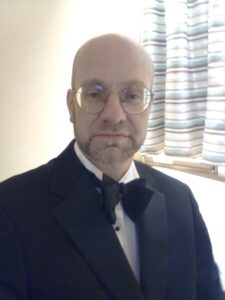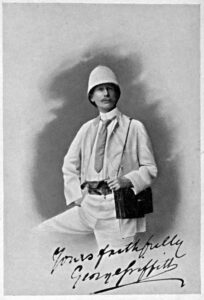From New Year’s Eve to NASA rockets the ‘countdown’ is common language today but it was an overlooked late 19th Century science fiction writer who first introduced it.

OU PhD student Adam Baldwin
Academic Adam Baldwin from The Open University (OU) says the ‘countdown’ is normally credited to film maker Fritz Lang in his 1926 film The Girl in the Moon.
But whilst Lang may have popularised it, the first use was in the short story by Englishman George Griffith’s The Great Crellin Comet from 1898, according to Adam, an English Literature PhD student.
Griffith proved to be an important influence on early science-fiction writing ahead of the hugely successful War of the Worlds writer, H.G. Wells.
Yet Adam is so fascinated by Griffith, who was also a journalist, globetrotter and, it seems, a heavy drinker who died prematurely from cirrhosis of the liver in 1906 aged 48, that he’s focusing his PhD thesis on the once-popular writer.
Other research material intriguingly claims Griffith himself described his recreational pursuits as “loafing, travelling and sailing”.

George Chetwynd Griffith
By the time Griffith died he had circumnavigated the globe seven times, three of them before the age of 19 – he had left school three years before in 1874 and went to sea.
By 1893, he was a published author with his first novel, three years before Wells, who it’s said was not a fan, but it’s Wells who eventually went on to eclipse Griffith.
Griffith penned 44 novels across multiple genres between 1893 and his death, as well as a stream of many short stories, poems and articles.
Adam discovered George Chetwynd Griffith, as he was also known, eight years ago when he picked up a modern reprint of Griffith’s first novel The Angel of the Revolution (1893).
“I was fascinated by this story of an underground revolutionary group, led by the mysterious and mesmeric Natas who, having exclusively obtained the knowledge of heavier-than-air flight, end a catastrophic world war and go on to impose a world-wide socialist utopia.”
This was a time some ten years before the Wright brothers turned science fiction into science fact when they finally succeeded at flying a plane at Kitty Hawk, North Carolina in the US.
Once he’d discovered Griffith, Adam learned that finding information on him was as rare as meteorites falling from the sky.
“Griffith was an important influence on early science fiction and predates H.G. Wells’ first successes by just a couple of years. Most of his personal papers were destroyed after his death but I’ve been able to flesh out some details through my research.
“His writing style is rough, but exciting. No prizes for literature, but quite a page turner if you can deal with the kind of prose the late Victorians were used to.
“Quotes are thin on the ground [about him], outside of reviews, although Wells knew of him, and didn’t rate him, although I suspect there was an element of personal jealousy there,” says Adam.
In a letter to his literary friend Arnold Bennett in 1902, Wells rails at comments in the American press which lumped him in the same category as Griffith by describing their work as “purveyor of wild ‘pseudo’ scientific extravaganza”.
To which Wells said:
“Stupid praise at this juncture would do me vast harm, insincere advertisement exaggeration of what I am.”
Science fiction and fantasy writer Michael Moorcock is quoted as saying Griffith was the first professional science-fiction writer.
Adam added:
“The brief glimpses we have into Griffith’s life are tantalising, if lacking in detail. They do, however, imply a restless man, steeped in both the classics and the popular literature of the day, always working, ready to travel or write a new novel, or both, at a moment’s notice.”
Main picture: Shutterstock



